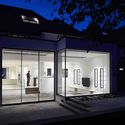
-
Architects: Robert Hirschfield Architects
- Area: 335 m²
- Year: 2016
-
Photographs:Matt Clayton
-
Manufacturers: Fowler & Co, Maxlight

Text description provided by the architects. An extensive redevelopment of an Edwardian semi-detached house in north London, dramatically re-ordering rooms and extending the house to the rear to meet the evolving needs of a couple and their teenage children.

This large period house required significant untangling from its congested internal layout in order to rationalise and re-configure its interior spaces. It also had a lack of connectedness to it’s generous outdoor spaces and an under-exploited loft area.

The original living and service areas of the house were dark, cramped and restrictive to family shared spaces. Our solution was to reconfigure the layout of each floor and expand the house to create a spacious living area to the rear of the ground floor with a large glazed structure that frames the newly landscaped garden and terrace.

The re-configured floors have given the family generous sized rooms with an interesting play of level changes and volumes that can now be fully shared and enjoyed. These are connected by a new helical staircase with a ribbon-like handrail that curves as it ascends in parallel with the central double-height void.

The new loft bedroom is the proud possessor of its own private recessed terrace that has cleverly and discretely been carved into the pitch of the roof.
The bathrooms, bedrooms and living spaces have bespoke built-in joinery, storage spaces and shelving all of which have been fully integrated into the overall concept and design.

Throughout the house, the warmth and texture of the wood grain used for the staircase has been emphasised in floor finishes and worktops elsewhere.

Product Description. The bespoke timber staircase was designed in close collaboration with designer-maker, Fowler & Co. It was conceived as a single object stretching between the ground, first and second floors. The central form comprises a solid helical balustrade that ‘hangs’ down the middle of the void with the stair wrapping around it. The elegant lacquered balustrade is capped with a continuous moulded handrail, hand carved from oak to match the fluid underside that follows the curves of the staircase.

It was made in Fowler & Co’s workshop and then assembled on site, with the handrail made from pieces of laminated wood pressed into a curved mould. The underside is clad with timber with each piece acting like a propeller blade, twisting in two directions. The result is a sinuous shape that is given continuity by the use of treated hand carved oak for both the underside and the ribbon-like handrail.














